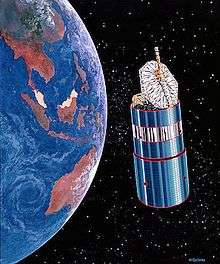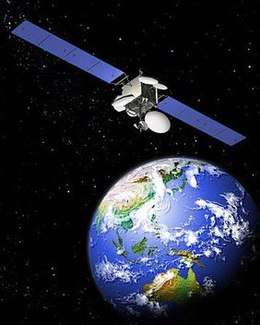MEASAT Satellite Systems
MEASAT Satellite Systems Sdn. Bhd, formerly Binariang Satellite Systems Sdn. Bhd is a Malaysian communications satellite operator, which owns and operates the MEASAT (Malaysia East Asia Satellite) and AFRICASAT spacecraft. The company provides satellite services to leading international broadcasters, Direct-To-Home (DTH) platforms and telecom operators. With capacity across six communication satellites, the company provides satellite services to over 150 countries representing 80% of the world's population across Asia, Middle East, Africa, Europe and Australia.

History
In 1993, Malaysia's Prime Minister, Dr. Mahathir Mohamad, called for the end of the Malaysian government's monopoly on communications services. He believed that the creation of privately owned companies could better serve Malaysia's communications needs in the decades ahead. One result of Mahathir's 1993 "Malaysia Plan" was the creation of the Binariang Sdn. Bhd. company by Malaysian tycoon Ananda Krishnan, which was given the charter to develop Malaysia's first satellite communications system. In 1994, Binariang signed a contract with Hughes Space and Communications Company (now Boeing Satellite Systems) for two Model 376 satellites. The project was named the "Malaysia East Asia Satellite" program, or "MEASAT" for short. The satellites opened the door to reliable telephone and data transmission services to all of Malaysia, helping to strengthen the unity between the peninsula and the island portions of the nation. The satellites also contributed greatly to the rapid growth of computer networking in Malaysia, as well as the creation of a new direct-to-home (DTH) satellite television service, called "Astro".
Since the launch of MEASAT-1 and MEASAT-2 in 1996, the company has expanded its fleet to across six (6) geostationary satellites designed and built by Boeing Satellite Systems, Orbital Sciences Corporation, Loral Space & Communications, and Airbus Defence and Space.
MEASAT-1 (AFRICASAT-1) and MEASAT-2

As advanced Model 376 spacecraft, the MEASAT-1 and -2 satellites have three enhancements over the standard model. They were the first in the 376 series to be fitted with gallium arsenide solar cells, which deliver 40 percent more payload power as compared to their silicon predecessors. They were also the first Model 376s to use lightweight, high-gain shaped antenna. The satellites also used a more efficient bipropellant system for stationkeeping and attitude control maneuvers.
Both MEASAT-1 & 2 satellites were launched on Ariane rockets from Centre Spatial Guyanais at Kourou in French Guiana. MEASAT-1 was launched in January 1996 and MEASAT-2 was launched in November 1996. MEASAT-1 was located in a geostationary orbit at 91.5 degrees East, and MEASAT-2 was located in a geostationary orbit at 148 degrees East. The contract with Hughes also called for the installation and testing of equipment for a satellite control station on Langkawi Island, and training of Malaysian spacecraft controllers.
MEASAT 1 had five high-power transponders in Ku band for the direct-to-user service, powered by 112-watt traveling-wave tube amplifiers. The regional service to Malaysia was provided on 12 transponders in C band, using 12-watt solid state amplifiers. MEASAT-2 had 11 active transponders in Ku band. Eight of these use 95-watt traveling-wave amplifiers, and three have 62 watts. MEASAT-2 also had six active transponders in C band, powered by 12-watt solid-state amplifiers.
In the latter part of 2009, MEASAT-1 was still functioning reliably beyond its planned 12 year life. With help from Boeing Satellite Systems, MEASAT drift relocated MEASAT-1 from its 91.5°E orbital location, across the Indian Ocean to provide service to the African continent from 46°E. In January, 2010, MEASAT renamed MEASAT-1 as "AFRICASAT-1". The satellite was de-orbited and sent to a 'graveyard' orbit in April 2013 once it reached its end-of-life.
| Orbital Location | 91.5°East (0°N 91.5°E) |
| Geographic Coverage | South East Asia, northern Australia and Guam |
| Launch Year | 1996 |
| Present Status | De-orbited |
| Type of Satellite | Boeing 376 HP |
| Launch vehicle | Ariane 4 |
| Design Lifetime | 12 years |
| SSPA Power | 12 Watts |
| Transponder Bandwidth | 12×36 MHz |
| Channel Polarization | Linear |
| Orbital Location | 148°East (0°N 148°E) |
| Geographic Coverage | Asia Pacific and Hawaii |
| Launch Year | 1996 |
| Present Status | De-orbited |
| Type of Satellite | Boeing 376 HP |
| Launch vehicle | Ariane 4 |
| Design Lifetime | 12 years |
| SSPA Power | 12 Watts |
| Transponder Bandwidth | 6×72 MHz (C-band), 6x48 MHz (Ku-band) |
| Channel Polarization | Linear |
MEASAT-3

MEASAT-3 is a Boeing 601 HP spacecraft. It was launched on 12 December 2006 from the Baikonur Cosmodrome, Kazakhstan.[1]
MEASAT-3a
MEASAT-3a was constructed by Orbital Sciences Corporation under their Star-2 platform. It was launched on 21 June 2009 from the Baikonur Cosmodrome, Kazakhstan
MEASAT-3b
MEASAT-3b was constructed by Airbus Defence and Space. It was launched on 12 September 2014 MYT from Centre Spatial Guyanais at Kourou in French Guiana.[2]
References
- Archived December 16, 2006, at the Wayback Machine
- Qishin Tariq (12 September 2014). "Malaysia's Measat-3b satellite successfully launched into space". The Star. Retrieved 13 September 2014.
Further reading
- Bigger, better and faster with Measat-3, The Star, 12 December 2006
- ILS Proton Successfully Launches MEASAT-3 Satellite, BAIKONUR COSMODROME, Kazakhstan, 12 December 2006
- Boeing Receives First Signal from New MEASAT-3 Satellite, ST. LOUIS, 12 December 2006
- Measat 3 Interference, Telco Talk Malaysia, April 2007
External links
- MEASAT Satellite Systems Official Website
- Boeing's Satellite Development Center
- MEASAT-3B launch date
- IMS Official provider's site
- AfricaSat 1 / MEASAT 1 Channels at Satepedia